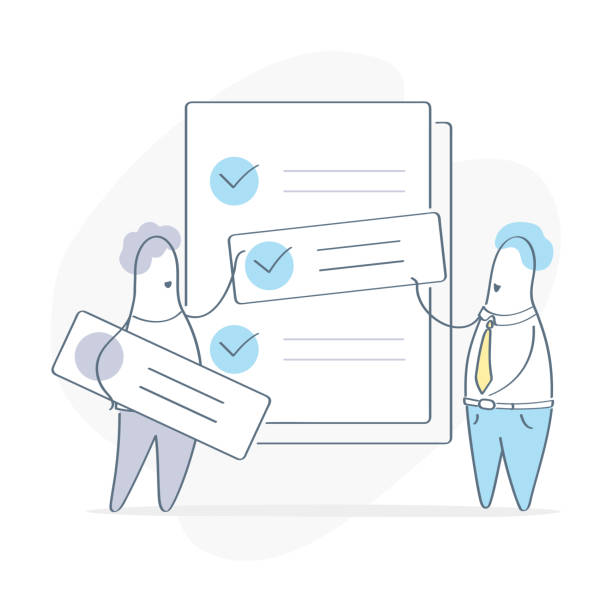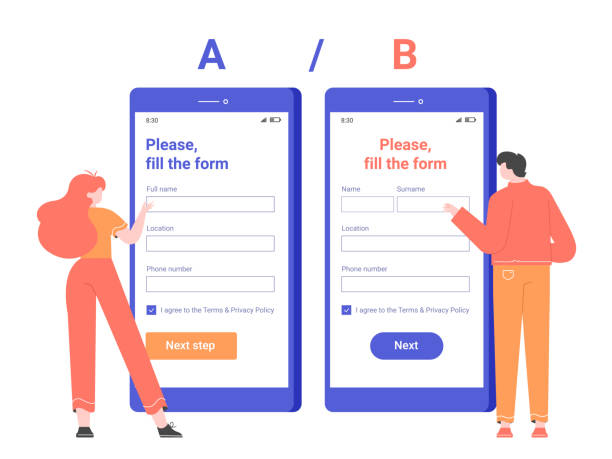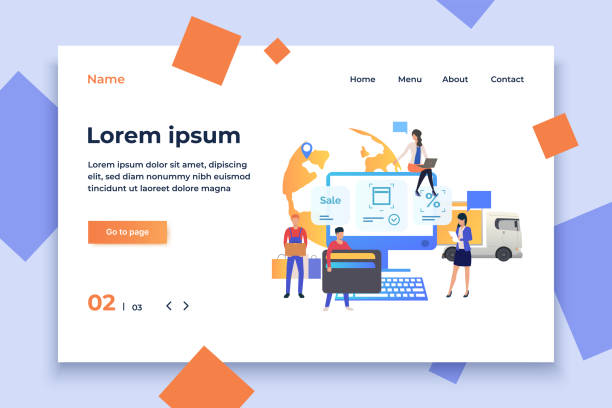Introduction to Secure Website Design and its Importance in the Digital Age

In today’s fast-paced world, an online presence is vital for any business or individual.
But with the expansion of the digital space, security challenges have also increased.
#Secure_Website_Design is no longer a luxury choice, but a critical necessity.
The main goal of designing a secure website is to protect sensitive user data and ensure the integrity and availability of information.
Without adhering to security principles, a website can easily become the target of cyberattacks, leading to data breaches, loss of customer trust, and heavy financial losses.
This educational section will help you gain a deeper understanding of the various dimensions of web security.
In fact, website security is not just about installing an SSL certificate; rather, it requires a comprehensive, multi-layered approach that begins from the very start of the development process.
The high importance of cybersecurity in maintaining the credibility and longevity of any online platform is undeniable.
A vulnerable website not only exposes confidential user information to risk but can also be exploited as a point of attack on other systems or for distributing malware.
This comprehensive explanation regarding the necessity of paying attention to secure website design principles is the cornerstone for understanding the subsequent steps.
Worried your old company website is scaring away new customers? RasaWeb solves this problem with modern and efficient corporate website design.
✅ Increases your brand’s credibility.
✅ Helps attract targeted customers.
⚡ Contact RasaWeb for a free consultation!
Basic Principles of Web Security and Preventing Vulnerabilities in Secure Website Design

To achieve secure website design, familiarity with the basic principles of web security is of paramount importance.
One reliable resource in this area is the OWASP Top 10 list, which introduces the most common web security vulnerabilities.
These vulnerabilities include Injection attacks, Broken Authentication, Sensitive Data Exposure, and Security Misconfiguration.
Specializing in these areas helps developers write their code more carefully and prevent the creation of security loopholes.
Adhering to the principle of least privilege, regularly updating software and libraries, and using secure frameworks are among the measures that should be considered in every secure website design project.
All development teams must receive the necessary training on OWASP Top 10 principles and continuously update their knowledge in this field.
Implementing layered defense mechanisms, such as using Web Application Firewalls (WAF) and Intrusion Detection and Prevention Systems (IDS/IPS), can also help increase the overall stability and security of the website.
In today’s world, where cyber threats are rapidly evolving, having a proactive and analytical approach to security is a guarantee of long-term success and stability for any online platform.
Therefore, paying attention to all aspects of ensuring website security in the early stages of design is more critical than ever.
Implementing SSL/TLS Certificates and Their Role in Secure Website Design

One of the most fundamental and vital steps in secure website design is the implementation of SSL/TLS certificates.
These certificates encrypt data between the user’s browser and the website server, preventing eavesdropping, tampering, or theft of information during transmission.
Websites that use HTTPS not only have higher security but also achieve a better ranking in search engines like Google.
An educational guide on the types of certificates, including Domain Validation (DV), Organization Validation (OV), and Extended Validation (EV) certificates, helps in choosing the most suitable option for your website’s security needs.
Using HTTPS is no longer just a recommendation; it is an industry standard for any website looking to secure its online platform.
| Certificate Type | Validation Level | Main Application | Trust Level |
|---|---|---|---|
| Domain Validation (DV) | Low | Blogs, personal websites | Basic |
| Organization Validation (OV) | Medium | Corporate websites, e-commerce | Medium |
| Extended Validation (EV) | High | Banks, financial institutions, large corporations | High (green bar in browser) |
A key guideline is to always use the latest TLS protocols (such as TLS 1.3) and disable older, vulnerable protocols (such as SSLv3 or TLS 1.0/1.1).
This helps to strengthen communication security and prevent specific attacks like POODLE.
Finally, proper key management and ensuring the validity and up-to-dateness of certificates are an inseparable part of the secure website design process.
Neglecting this section can render all your efforts for secure website design ineffective.
Defense Against Injection and Cross-Site Scripting Attacks in Secure Website Design

Injection Attacks and Cross-Site Scripting (XSS) are among the most common and dangerous threats to any website.
In secure website design, effective defense against these attacks is vital.
Injection attacks, such as SQL Injection, enable attackers to inject malicious code into application inputs to access or manipulate the database.
To prevent these attacks, the most specialized approach is to use Prepared Statements or ORMs (Object-Relational Mappers) which securely manage user inputs.
On the other hand, XSS attacks allow attackers to inject malicious JavaScript code into legitimate web pages, stealing user information or taking control of their sessions.
The solution to this problem is proper Output Encoding of all input data before displaying it on the web page.
This includes using specific functions to convert special characters into HTML entities.
Training the development team on these vulnerabilities and implementing secure coding standards is an important part of any guide for secure website design.
Using Content Security Policy (CSP) can also act as an additional defensive layer against XSS attacks.
Any questionable content originating from user input must be rigorously reviewed and filtered to prevent any misuse.
A thorough analysis of data input and output points on the website can significantly help in identifying and addressing potential vulnerabilities.
Did you know that customers’ first impression of your company is your website? With a powerful corporate website from RasaWeb, multiply your business’s credibility!
✅ Custom and eye-catching design tailored to your brand
✅ Improved user experience and increased customer acquisition
⚡ Get a free consultation!
Secure Session Management and Strong Authentication in Secure Website Design

User session management and strong authentication mechanisms are two main pillars in any secure website design.
A weak authentication system or improper session management can open the way for unauthorized access by attackers.
Using strong passwords, implementing Two-Factor Authentication (2FA) or Multi-Factor Authentication (MFA), and limiting unsuccessful login attempts are among the best practices.
These educational measures help users keep their accounts more secure.
Regarding session management, session tokens should be securely generated (random and long), transmitted via HTTPS, and have a limited lifespan.
Another explanation is that session tokens should be invalidated after each login or password change.
Additionally, using HttpOnly and Secure cookies for session tokens prevents client-side scripts from accessing them, thereby increasing security.
This specialized section emphasizes the importance of meticulously implementing these mechanisms.
Without a strong authentication system, even the best security measures in other areas will be ineffective.
User security must be a priority, and every secure website design must be based on this principle.
Providing comprehensive guidance to users on how to choose strong passwords and use 2FA is an important part of developers’ responsibility.
Continuous review and analysis of authentication logs can help identify suspicious patterns and brute-force attacks.
Website security should be optimized not only technically but also from a user experience perspective.
The Role of Firewalls and WAF in Website Protection and Secure Website Design

Firewalls and Web Application Firewalls (WAFs) play a crucial role in protecting websites and strengthening secure website design.
Traditional firewalls operate at the network layer, filtering incoming and outgoing traffic based on predefined rules.
These firewalls can help prevent Distributed Denial of Service (DDoS) attacks and unauthorized access to server ports.
However, WAFs provide a deeper security layer.
They analyze HTTP/HTTPS traffic at the application level and are capable of identifying and blocking more complex attacks such as SQL Injection, XSS, and CSRF.
A WAF, by examining the content of requests and responses, can detect malicious patterns and block them before they reach the website.
These tools are essential for any large-scale website security assurance.
Correct selection and configuration of a WAF require expertise and can significantly elevate your website’s security level.
Some WAFs are cloud-based and act as a security service, while others are installed on-premises as software or hardware.
News regarding the latest cyber threats and how WAFs counter them can be very useful in updating WAF rules.
Guidance for choosing the appropriate WAF should be based on the type of traffic, budget, and the organization’s risk tolerance.
This defensive layer is particularly valuable in scenarios where secure website design needs to be protected from a high volume of attacks.
Continuous analysis of WAF logs is also crucial for identifying attack patterns that might bypass existing rules.
This section demonstrates in the most entertaining way how advanced technologies can stand against attackers.
Continuous Updates and Security Patches for Secure Website Design

One of the most important yet often overlooked aspects of secure website design is the continuous updating of software and application of security patches.
Attackers are constantly looking for new vulnerabilities in operating systems, frameworks, Content Management Systems (CMS), and plugins.
A website with outdated software and components can easily become a target for attacks.
Regular training for the website development and maintenance team on the importance of this topic is key.
The guideline is to establish a regular plan for checking and applying updates.
| Component | Suggested Update Period | Importance |
|---|---|---|
| Server OS | Monthly / Upon security patch release | Very High |
| Framework/Programming Language | Quarterly / Upon new stable version release | High |
| CMS (WordPress, Joomla, etc.) | Upon security patch release | Very High |
| Plugins / Modules | Upon security patch release | Medium to High (depending on usage) |
| Third-party Libraries | Periodically / Upon security patch release | Medium |
This is an important explanation for maintaining website security.
The questionable content regarding whether updates should always be applied immediately is answered with yes, but cautiously and after testing in a non-production environment.
Security news (Threat Intelligence) can help you stay informed about newly discovered vulnerabilities and quickly apply necessary patches.
A secure online platform requires continuous and specialized attention to detail.
Failure to update can lead to attacks that were easily preventable.
Therefore, an inseparable part of secure website design is planning for regular maintenance and patching.
Penetration Testing and Vulnerability Assessment in Secure Website Design
![]()
After implementing the principles of secure website design, the next crucial step is continuous security testing and evaluation.
Penetration Testing and Vulnerability Assessment are two powerful tools for identifying weaknesses before attackers discover them.
Vulnerability assessment involves using automated tools to scan the website and identify known vulnerabilities.
This is a descriptive and quick process that can provide a list of potential issues.
However, penetration testing is a specialized and manual approach conducted by Ethical Hackers.
These hackers simulate real attacks, attempting to penetrate the system and discover vulnerabilities that automated tools cannot detect.
A detailed analysis of penetration testing findings can help developers address the most fundamental security issues.
This process often generates questionable content regarding security blind spots in a secure online platform and challenges the team.
Conducting penetration testing periodically, especially after major changes in code or infrastructure, is strongly recommended.
The guidance is to seek assistance from experienced cybersecurity professionals for this task.
Reports from these tests should be carefully reviewed, and a comprehensive plan for addressing vulnerabilities should be developed.
News about the latest penetration testing methods and tools used in this field can help security teams always stay one step ahead of attackers.
This process ensures that your secure website design is not only theoretically robust but also practically resilient and impenetrable.
Did you know that 94% of the first impression of a company is related to its website design?
RasaWeb, by providing professional corporate website design services, helps you create the best first impression.
✅ Create a professional and trustworthy image for your brand
✅ Easier attraction of potential customers and improvement of online standing
⚡ Get a free corporate website design consultation!
Backup and Disaster Recovery Planning in Secure Website Design

Even with adherence to all principles of secure website design, there is always the possibility of disaster; from successful cyberattacks to hardware failures or human errors.
Therefore, having a robust backup program and a Disaster Recovery Plan is essential for any secure online platform.
Regular backups of website data and source code ensure that in case of any problem, the website can be restored to its state before the incident.
The guidance is that backups should be stored in secure locations, preferably separate from the main server (for example, in cloud storage or offline servers).
This explanation of various backup methods, including Full Backup, Incremental Backup, and Differential Backup, can help in choosing the appropriate strategy.
A disaster recovery plan is a document that outlines the precise steps for restoring systems and data after a security or technical incident.
This plan should include roles and responsibilities, required tools, and Recovery Time Objective (RTO) and Recovery Point Objective (RPO).
Training the recovery team on how to execute this plan is crucial.
This specialized process requires periodic testing to ensure its effectiveness.
A website with secure website design is truly secure only if it can quickly return to normal operation after an attack or disaster, with minimal data loss.
Regular analysis of potential weaknesses in the backup and recovery process helps in the continuous improvement of this vital aspect of website security.
This section is entertaining because it gives you peace of mind that even in the worst-case scenarios, your website is recoverable.
Education and Awareness for Users and Development Team in Secure Website Design

No secure website design is complete without considering the human factor.
Many cyberattacks occur through social engineering or exploiting the unawareness of users and even developers.
Therefore, continuous education and awareness for both end-users and the development team is a critical component of website security strategy.
For users, guidance on choosing strong passwords, identifying phishing emails, the importance of two-factor authentication, and avoiding clicking on suspicious links is essential.
This simple explanation can play a significant role in preventing many attacks.
On the other hand, the development team must be regularly trained on the latest vulnerabilities, best practices for secure coding, and security testing tools.
This is the most specialized part of website security management.
Holding educational workshops, sharing security news, and promoting a security culture within the organization can significantly enhance website security.
The questionable content regarding whether developers have enough time for these trainings should be taken seriously by management.
A knowledgeable team committed to security principles is the backbone of any secure website design.
Analyzing human weaknesses through controlled phishing attack simulations and evaluating employee responses can help identify further training needs.
Ultimately, making the security learning process fun can help information stick better in the minds of users and developers.
Frequently Asked Questions
| Row | Question | Answer |
|---|---|---|
| 1 | What is secure website design? | Secure website design is a process where websites are built with security measures in mind from the initial development stages to protect against cyberattacks, unauthorized access, and data loss. |
| 2 | Why is secure website design important? | Website security is crucial for maintaining user trust, protecting sensitive information (personal and financial), preventing damage to brand reputation, and complying with privacy and security regulations (such as GDPR). Security breaches can lead to financial and legal damages. |
| 3 | What are the most common cyberattacks a website faces? | Some of the most common attacks include SQL Injection, Cross-Site Scripting (XSS), Distributed Denial of Service (DDoS), Brute Force, and Credential Stuffing attacks. |
| 4 | What is SQL Injection and how to prevent it? | SQL Injection is a type of attack where the attacker attempts to manipulate the database or extract information by injecting malicious SQL code into site inputs. To prevent it, Prepared Statements/Parameterized Queries, ORM (Object-Relational Mapping), and strict input validation should be used. |
| 5 | What is Cross-Site Scripting (XSS)? | XSS is a type of attack where an attacker injects malicious scripts (usually JavaScript) into legitimate web pages, which are then executed by other users’ browsers. This can lead to the theft of cookies, session information, or alteration of the website’s appearance. |
| 6 | How can Brute Force attacks on login pages be prevented? | To prevent Brute Force attacks, CAPTCHA, limiting the number of unsuccessful login attempts (Account Lockout), Two-Factor Authentication (2FA), and using complex and long passwords should be employed. |
| 7 | What is the role of HTTPS in website security? | HTTPS uses SSL/TLS to encrypt the communication between the user’s browser and the website server. This prevents eavesdropping, tampering, or forging of information during transmission and increases user trust. |
| 8 | What is the importance of Input Validation in security? | Input Validation is the process of checking and sanitizing data entered by the user. This prevents the injection of malicious code, XSS, SQL Injection, and other vulnerabilities, ensuring that the data conforms to the expected format. |
| 9 | Why is regular updating of website systems and software necessary? | Regular updates of the operating system, CMS (like WordPress), plugins, themes, and libraries used resolve known security vulnerabilities. Hackers often exploit weaknesses in outdated software to gain unauthorized access. |
| 10 | What role does regular backup play in secure website design? | Regular and tested backups of website information (database and files) are a critical layer of defense against data loss due to cyberattacks, human errors, or hardware failures. This allows for quick website recovery in case of disaster. |
And other services of RasaWeb Advertising Agency in the field of advertising
- Smart Content Strategy: Professional optimization for sales increase using intelligent data analysis.
- Smart Data Analysis: Professional optimization for improving SEO ranking by optimizing key pages.
- Smart Advertorials: Exclusive service for growing user engagement based on real data.
- Smart Marketing Automation: A novel service for increasing customer behavior analysis through attractive user interface design.
- Smart Digital Advertising: A creative platform for improving click-through rate increase with intelligent data analysis.
And over hundreds of other services in the field of internet advertising, advertising consultation, and organizational solutions
Internet Advertising | Advertising Strategy | Advertorial
Sources
Secure Website Design Guide
Security Tips for Webmasters
Protecting User Data on the Website
Website Security Checklist
? Are you looking to elevate your business in the digital world? RasaWeb Afarin Digital Marketing Agency, by offering comprehensive SEO-optimized website design services, helps you shine in the online space and achieve your goals. With us, experience a powerful and memorable presence.
📍 Tehran, Mirdamad Street, next to Central Bank, Southern Kazerun Alley, Ramin Alley, No. 6



